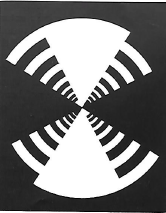Previous Communication Tour Stop | Return to Communication Tour Map | Next Communication Tour Stop
Previous Bardeen Quad Tour Stop | Return to Bardeen Quad Tour Map | Next Bardeen Quad Tour Stop
Raymond H. DuHamel was an Electrical Engineer who received his Ph.D. from the University of Illinois in 1951. A few years after earning his doctorate, Dr. DuHamel worked with John Dyson and Victor Rumsey at the university’s Electrical Engineering Lab to invent the first radio telescope to have log-spiraled antennas mounted onto the antenna’s focus in 1961.
Raymond H. DuHamel, was born in Tuscola, Illinois, the son of S.S. and Florence Maris DuHamel. He attended Springfield High School and earned his doctorate in electrical engineering from the University of Illinois in 1953. Upon completion of his degree, he obtained a position in the Electrical Engineering Department in antenna research where he aided in the development of frequency independent antennas from 1953 – 1956.
A military need for more better-designed antennas had brought about the University of Illinois to begin research into antennas in 1948. The initial project for the electrical engineering team was to create an antenna for high-speed aircrafts. In 1954, DuHamel was the only full-time staff member in the Illinois Antenna Lab, so he decided to hire engineers John Dyson and Victor Rumsey to help him work on the project to research antennas for high-speed aircrafts. It was within this project that Duhamel conceived the idea of the first log-periodic frequency-dependent antenna.
Throughout their research into figuring out how to design the best antenna possible, there were several failed attempts. One of these failed attempts was the design of the “toothed bow- tie” also known as the “log-periodic toothed bow-tie” antenna. The antenna was thought to be frequency independent. However after countless tests they discovered that this was not true and it had the same limitations as the equiangular spiral.

After many failed research attempts, in March of 1961, DuHamel, along with the help of his team, patented his first design of a log-periodic frequency-independent antenna. In May of 1961, DuHamel patented another kind of log-periodic antenna which allowed us to receive efficient signals from outer space.
The log period antenna is can function over a large range of frequencies and has a circularly polarized receiving pattern. This design was important to the radio telescope. The log-periodic antenna enabled it to aim the receiving beams of the telescope. These antennas had been successfully designed to receive bandwidth ratios of 40 to 1 or higher. The whole development of this antenna went from being impossible to widespread use within 10 years.
What was originally designed to help the military, the antennas soon became the most popular on the market for television signaling. These log-periodic antennas allowed for the reception of television signals in areas where it had been challenging to get any TV signal at all. Through DuHamel’s perseverance to design a high-frequency antenna for the military, DuHamel’s antenna design became a revolutionary innovation for America’s booming television industry.
– Everitt Laboratory. This was where the department of electrical engineering was located when DuHamel was a student and working for the electrical engineering department.
Alumni and Faculty Biographical/Morgue File, on DuHamel obituary. Record Series 26/4/1. University of Illinois Archives.
Chicago Tribune. (1963, January 23) U.I. Research Triumphs in Electronics. Chicago Tribune. Retrieved from http://archives.chicagotribune.com/1963/01/23/page/30/article/u-i-research-triumphs-in-electronics. (Updated link here).
Edward C. Jordan Papers. Duhamel. Record Series 11/6/27, Boxes 3, 6, 13. University of Illinois Archives.
Kingery, R. A., Berg, R. D., & Schillinger, E. H. (1967). Men and Ideas in Engineering. Urbana, IL: University of Illinois Press. Image toothed bow tie p. 81 [endcollapsed-pane]
